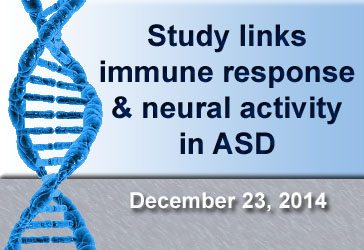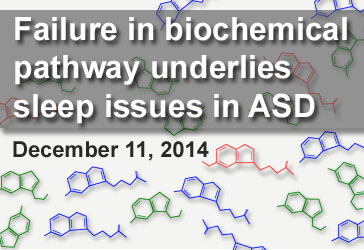Archives
December, 2014
Select a different month in the archive
Inflammation-Related Genes Ramped Up in ASD
By Chelsea E. Toledo, M.A. on December 23, 2014

Background: The root cause, or causes, of Autism Spectrum Disorder (ASD) remains unknown. Many studies point to a genetic component and have uncovered genetic glitches that appear in people with ASD. To understand how or whether those genes are expressed as traits, however, scientists would have to look for effects in the brain itself.
What’s new: On December 10, 2014, the journal Nature Communications published a large study on gene expression in the brains of people with ASD. The researchers examined 104 tissue samples from a total of 72 autopsied brains—47 from people with ASD and 57 controls with typical development. They found significant differences in gene expression within microglial cells, which respond to infectious agents and other threats that lead to inflammation in the brain. In the brains of people with ASD, they found that microglial cells were perpetually active, with genes for inflammation response turned on—likely a response to processes related to autism, and not the other way around.
Why it’s important: This is the largest data set examined to date on gene expression related to autism. Future studies could solidify whether treating inflammation could improve ASD symptoms.
Help me understand :
| Source(s) : |
| Tweet |
Scientists Piece Together Chemical Imbalances in ASD
By Chelsea E. Toledo, M.A. on December 11, 2014

Background: The chemicals serotonin and melatonin transmit important signals between brain cells. Serotonin helps to regulate mood, but it also converts into melatonin, an important regulator of sleep cycles. Previous studies have found separately that individuals with autism spectrum disorder (ASD) have elevated levels of serotonin and diminished levels of melatonin. That chemical imbalance is a suspected contributor to the behavioral and sleep issues observed in people with ASD.
What’s new: On November 11, 2014, the journal Translational Psychiatry published a study examining both chemicals—as well as N-acetylserotonin (NAS), the chemical serotonin becomes in the process of converting to melatonin. The researchers monitored levels of serotonin, NAS, and melatonin in the blood, platelets, and plasma, respectively, of 278 patients with ASD. When compared to 506 relatives unaffected by the disorder—as well as a control group of 416 people matched by age and sex—the group with ASD experienced significant disruption in the conversion of serotonin to NAS to melatonin. This disturbance was evidenced by high levels of serotonin and NAS and low levels of melatonin—with effects appearing most prominently in individuals with ASD and, to a lesser extent, in their blood relatives.
Why it’s important: This study sheds light on the relationship between serotonin, melatonin, and the intermediate chemical NAS as they relate to ASD. Future research can refine tests for disruptions in the level of these chemicals as biomarkers for the disorder. In addition, this study supports the possibility of melatonin as a therapeutic sleep aid for affected patients.
Help me understand :
| Source(s) : |
| Tweet |

